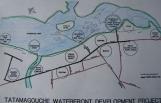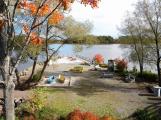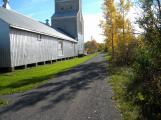1
In 1994, the deeds of the Creamery building, together with the Shed building (former garages for the cream trucks) passed into the hands of the village and a volunteer group was established to work on the Creamery and prepare for Community Events to be held there.This year also saw.the North Colchester Development Committee initiating the Tatamagouche Waterfront Development Project The goal was to improve and revitalize the waterfront area by creating attractions and amenities that integrated with those already existing in the village, thus creating a 'critical mass' that would benefit the locals and tourists. Over the next 5 years various studies took place,and some ideas were adopted while others disappeared.
It was thought that as Tatamagouche had in the past very successfully run a Festival of the Arts for a number of years and still had an annual 'Oktoberfest', there would be enough 'drive' to carry out the project.( Incidentally, the Oktoberfest is now the second largest in Canada)
The resulting 'Attraction cluster' would keep visitors overnight in the village, and thereby create more jobs.
In 1995 there was also a Waterfront Development Program designed to refurbish, revitalize and promote waterfront commercial areas throughout Nova Scotia.
Economic Development and Tourism, Atlantic Canada Opportunities Agency (ACOA), together with municipalities,and businesses were all working together to help bring about more jobs. Federal and Provincial governments gave $149,000 toward the project.
In 1996, Jimmie Lefresne chaired a meeting of the Tatamagouche Creamery Society stating that there was a need to preserve the old creamery equipment, and asked for ideas about how the old Creamery could serve the needs of the community
The Tatamagouche Bay Waterfront Committee (sub division of the North Shore Community Development Association) was made up of volunteers wishing to improve the waterfront. They were assisted by a consultant provided by CoRDA (Colchester Regional Development Association) who was instrumental in providing ideas. Amongst which were:
:
A Border garden of about 10.5 acres (4.25 hectares),along one side of the former rail path, with a circular walkway through gardens reflecting the different cultural groups in the area Sadly this did not take place
A Rail path -the track of the former Intercolonial Railway (Short Line) needed improvements to make it a safe and pleasurable trail walk - It seems to have been used by all kinds of vehicles, and people had dug gravel out of it. Work on the trail started and has continued ever since, becoming a very attractive and popular walk.
A Music and Art Camp usable from Spring to Fall. This would have simple wood buildings for sleeping and communal eating facilities. The courses would take place at other sites in the village. A general camp site was established in Nelson Park but with no emphasis on Music and Art. although the occasional local concert took place. There is no longer any camping in the park.
Roadside Tourist Direction panels that could be read from a parked car. These were to be erected either side of the village on Highway 6 running between Pictou and Pugwash. There is no evidence of them today,
A shuttle bus service taking visitors to different sites. - Fraser Cultural Centre, the museum, the gardens, Marina and Music/Art camp site. This did not come about although a waiting room for the bus appears on plans for the Creamery building
Meanwhile, volunteers were working on the Creamery building, making it usable as a Community Centre
This 5 year plan also included considerations for linking the village with the Barrachois Marina; beach access at Bayhead; an Interpretation Centre for the Brule fossils; a boat rental on the French River; improvements for the Anna Swan Museum and Archives and the Tourist Bureau going to the Fraser Cultural Centre
2
Tatamagouche Waterfront Development Project20th Century October 1994
Tatamagouche, Nova Scotia Canada
 Credits:
Credits:North Colchester Development Committee
3
As a result of all these plans, suggestions, ideas and hopes, some things were accomplished. A first 5 year plan was completed and by 1999 the following were in existenceTatamagouche Centre ( (The Atlantic Christian Training Centre) ran Ecotours and Educational courses, as well as conferences on a wide variety of topics
The Fraser Cultural Centre had an Art gallery, the Archives, a Tourist Bureau and Anna Swan exhibit.
The Sunrise Trail Museum was re-established on the Main Street
Plans were afoot for a Fossil Interpretation Centre, to display the Brule fossil discovery
The Creamery was used for a variety of things thanks to hard working volunteers and the Farmers' Market had moved there.
The concept of a beach access at Bayhead to the west of Tatamagouche did not take place, nor did the Board Walks across the marshes, although there are signs indicating the 18th century Acadian Dykes
A new Patterson Wharf for boat tours did not take place - at that time! The Wharf came later under different circumstances!
Since then progress has been made from the mid 2000's.
Adjacent to Main Street is a small garden with seats, (for respite during summer heat) , and a village Christmas Tree is placed there in December. There are four large flower containers bordering the side walk, and at various positions around the village are plant containers and small 'volunteer maintained' gardens. Individual shops also had containers of plants, so when the village participated in 'Communities in Bloom' competitions, it did very well.
Garbage and recyle bins have appeared around the village and Creamery Square
.
There is a new dock at Patterson Wharf, together with flower beds, a BBQ and sand pit for children. This was the result of the village being highlighted in the television program 'The Week the Women Went'.
Constructed by the men of the village while the women were away, the dock is a great asset and highly popular for picnics, music, wedding and graduation photographs and for just admiring the views.
Nelson Park has new attractions, with a memorial to the Acadians, and flower beds. More plans are afoot for 2013.
Bicycle rentals at the Creamery - these are not yet available, although anything is possible and new in 2012 were the cycle racks in Creamery Square.
A Historic Walking Tour handbook was produced in 2009/10 by the Heritage Centre and is available at their Gift Shop.. There is also a free 'Discovery is Fun' pamphlet, for youngsters walking or riding the trail, with suggestions for what to look for and find along the Butter Trail and in the Heritage Centre. This came out in 2012
4
Tatamagouche Centre20th Century. Circa 1950
Tatamagouche, Nova Scotia Canada
 Credits:
Credits:North Shore Archives
5
!994 also saw the Tatamagouche Centre studying the ' Potential Ecotourism sites along the North Shore' - highlighting the natural environment.Built in the 1950's originally the retreats and meetings had been held in an old house on the property, now used as a residence. The new building overlooks the confluence of the French and Waugh Rivers - 'the meeting of the waters' which in Mi'kmaq gave the name to Tatamagouche. The site for thousands of years was a gathering place for First Nations and much later Acadians and settlers from Montbeliard.
Since its conception, the Centre has been a place for those who care about leadership, spirituality, human relationships and social justice.Often running 60 programs a year, the Centre also offers hospitality to Churches, the Community and other organizations
1995-Tourism Nova Scotia compiled a study 'A proposal for themed Community Heritage Tourism Development' listing waterfront and cultural attractions
1998 The Department for Urban and Rural Development from Dalhousie University compiled a 'Tatamagouche Strategy Plan' - again identifying waterfront and ecotourism activities.
6
Fraser Cultural Centre (Northumberland Shore Arts Council)19th Century. Circa1889
Tatamagouche, Nova Scotia Canada
 Credits:
Credits:North Shore Archives
7
The Lillian Fraser House was built in 1889. In 1946 it became the village hospital using war surplus materials and when the new hospital was built in 1968 it became a home for the elderly for a while and then was leased to the Women of the Community . A Board of Directors was formed for the building to become a cultural centre for local festivities and events. So it became the Fraser Cultural Centre, with a view to. holding arts and craft shows of various kinds. The Northumberland Arts Council was formed whose aim is to preserve art, crafts and cultural activities along the North Shore area.8
A Sunrise Trail sign near Malagash, Nova Scotia30 July 2012
Junction of Malagash Road and Highway 6, Nova Scotia, Canada
 Credits:
Credits:Creamery Square Heritage Society
9
Earlier efforts to bring tourists to the North Shore resulted in roadside signs indicating the 'Sunrise Trail'. There are not many of these signs left now, and some certainly have distracting notices round them.The shore roads pass beautiful. unspoiled sea views, farm land and woods.........a delightful route for anyone on vacation wishing to avoid traffic, and not in a hurry!
10
Butter Trail going West from Creamery Square18 October 2012
Tatamagouche, Nova Scotia Canada
 Credits:
Credits:Creamery Square Heritage Society
11
In 2004, the section of the trail between Lockerby Bridge in the east and the meeting with Highway 6, in the west, was officially called The Butter TrailElsewhere much of the trail passes through forest land but in Tatamagouche from Creamery Square it runs west alongside the Waugh River, with changing wild flowers according to the month, eagles, cormorants, assorted ducks, geese and kingfishers and on to a rest site and picnic/ BBQ area at Patterson Wharf; on over the French River with its connections to the early ship-building era, past the land of the Tatamagouche Centre, an ancient Acadian graveyard, and so to Nelson Park, with access to the water - the warmest in Nova Scotia. The trail continues until it meets Highway 6 and then goes beyond that junction to Wallace, with its beautiful harbour.
12
Patterson Wharf from the Trail18 October 2012
Tatamagouche, Nova Scotia Canada
 Credits:
Credits:Creamery Square Heritage Society
